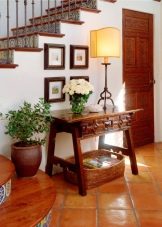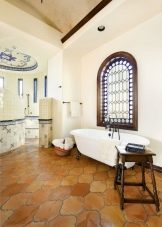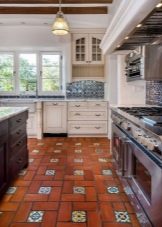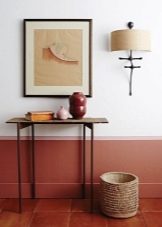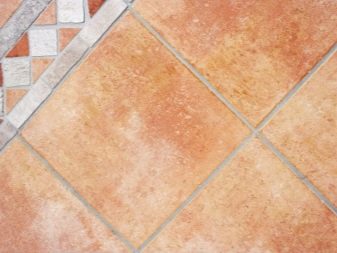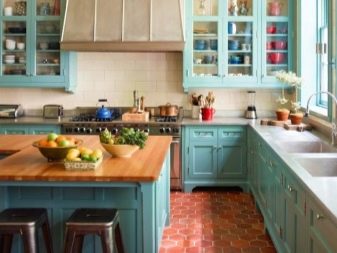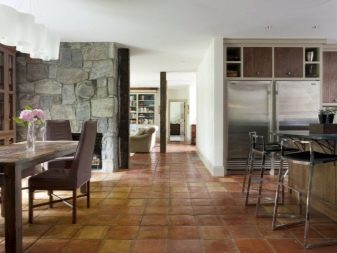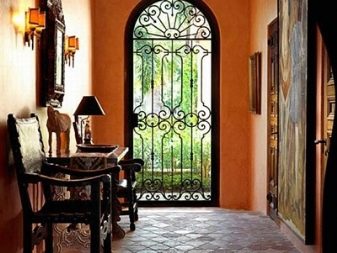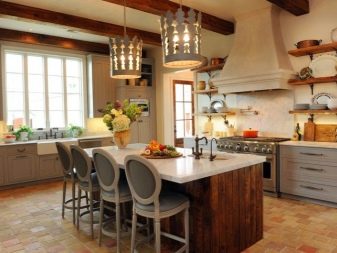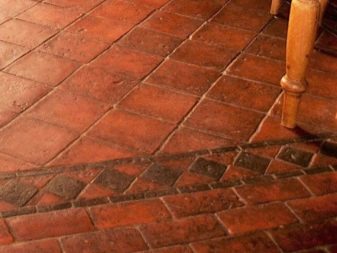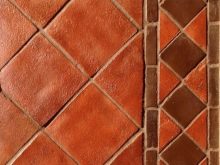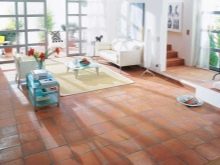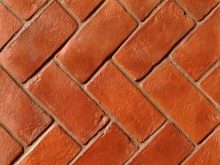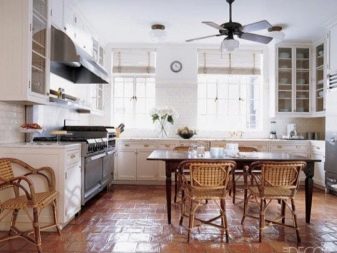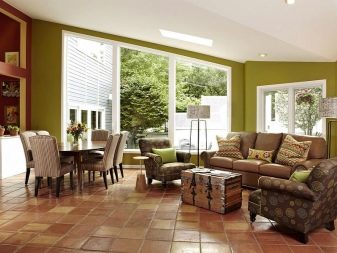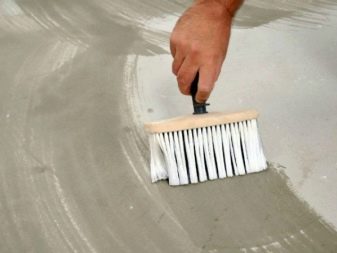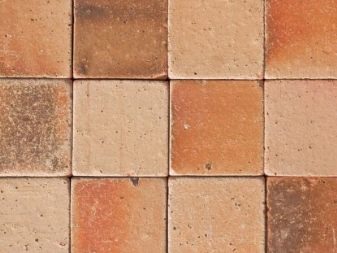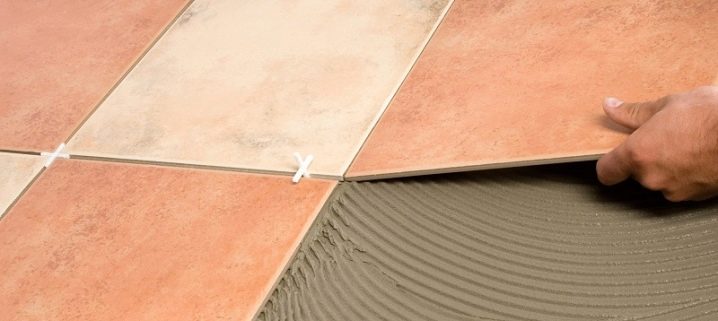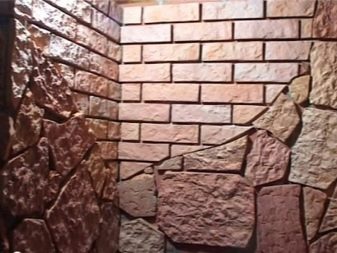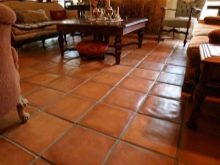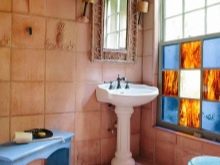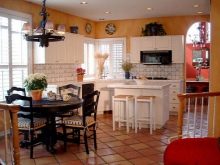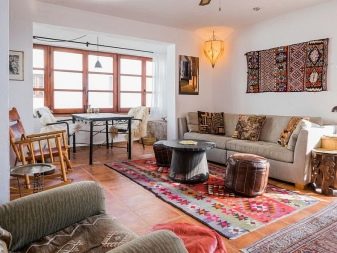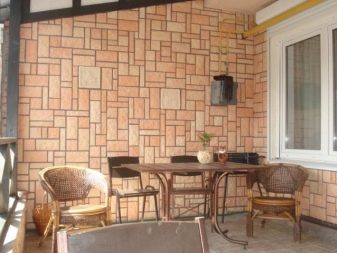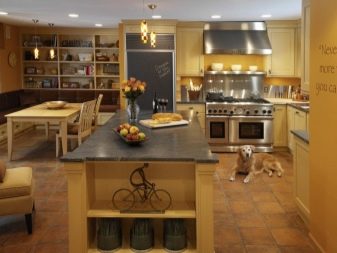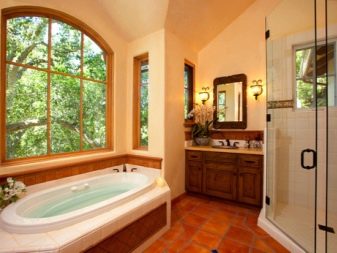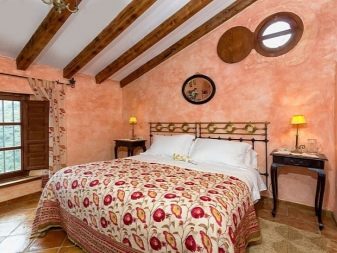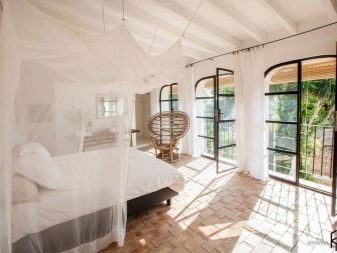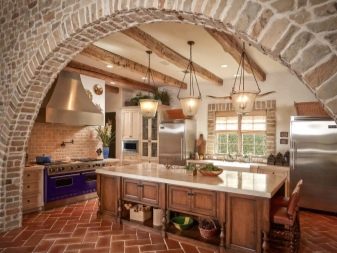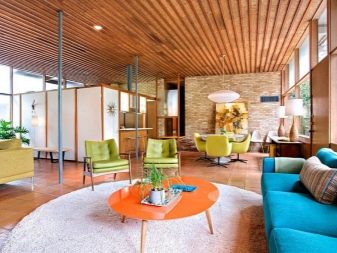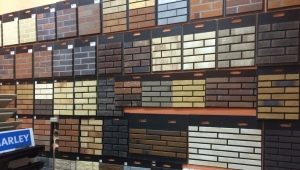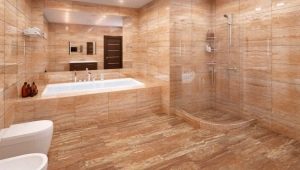Terracotta tiles in the interior
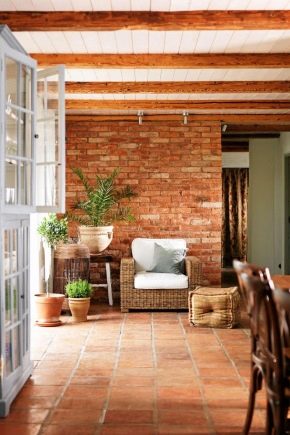
Terracotta is called glazed or unglazed tile, which is obtained from baked clay. Initially, it was created by hand and did not have a glazed coating, while being characterized by an impressive (up to 2.5 cm) thickness.
Translated from Italian, the name of the tile sounds like “burned earth”. Today, this material is used to design the floor, walls, fireplaces and decorative elements of the interior.
Special features
A feature of the tiles is the production technology. Unlike other types of tiles, which are fired at a temperature of 1200-1400С, "terracotta" is placed in a furnace with a temperature of up to 1000С. To obtain authentic terracotta tiles, refractory kalinic clay (white) is used, which simply will not withstand the effects of high (about 1000 ° C) temperatures.
As a result of this low-temperature firing, the finished material is characterized by 5-15% water absorption and has a porous texture. It can be inconvenient to use it in the interior without additional processing, therefore the material is additionally protected with varnishes, impregnations, after which it acquires moisture resistance.
The main feature of the tile is the rusticity of its style. The material is somewhat similar to Prague brick and wild stone. Sometimes deliberately careless tiles have imperfect dimensions, uneven edges and characteristic roughness. In the "correct" variation, even the presence of various kinds of defects, including traces of domestic animals, is permissible. This is explained by the fact that the tile dries out in natural conditions and at this moment pets (cats, dogs) can run through it.
The advantage of tile can be called:
- Environmentally friendly and non-toxic. It does not even have undesirable components for the human body.
- High fire resistance. Proof of this can be considered the use of tiles as heat-resistant bases for fireplaces. Moreover, the thermal “return” of terracotta-filled fireplaces increases by a factor of 2-3.
- Resistance to moisture, durability.
- Resistance to mechanical stress, abrasion.
- Resistant to UV rays.
- Special appearance. The use of the material allows to achieve unusual stylistic decisions, to convey the atmosphere of home comfort, nobility, naturalness.
- The richness of tile shades. The color range ranges from red-brown to light yellow, there are even black variants. To obtain a particular shade, manganese, cobalt or chromium oxide may be added to the calcining composition.
Scope of the material steel wall and floor facing, heat-resistant tiles are suitable for facing the stove, fireplace, saunas, baths. It is important that, due to its loose geometry, terracotta tiles will hide all the imperfections of the brickwork.
Form and design
The form of terracotta can be any. Traditional are square and rectangle, as well as a hexagon. In the latter case, the surface looks like a honeycomb.
Perhaps one of the main characteristics of the tile is its color. The warm, saturated terracotta has absorbed the tones and semitones of red with its energy, cheerful orange and brown, associated with measured calmness.
The interior, which uses terracotta tiles, gives a feeling of relaxation, security. Due to the fact that this shade belongs to natural, it harmoniously combines with other natural colors. While with artificial, the more acid shades it does not look.
First of all, it is worth mentioning the unbeatable combination of terracotta with cold and warm pastel colors, as well as white. Using tiles in a light beige or dairy range of the interior, you can visually enlarge the space, achieve a feeling of freshness.
The combination of terracotta tiles with a brown scale get cozy chamber rooms. Unusual style effects guarantees a combination of material with green (shade of foliage), turquoise, red, gray, blue.
Installation
Before laying the tiles, preparatory work should be done - clean and level the surfaces, remove traces of oil and bitumen, and old finishing materials. To level the surface and improve adhesion, you should use plaster and primer compositions.
Tiles of different lots may differ slightly from each other in tones.however, it is even good, because it allows to achieve maximum naturalness, the effect of a natural clay floor. To avoid a situation where one part of the surface is darker or lighter than the other, it is recommended to install tiles from several batches at once.
The tiles also differ in irregularities and minor differences in size. In this regard, the laying of the material is carried out with a wide gap between the tiles. This allows the latter not to “run away” from each other and not to disturb the masonry pattern. When facing the walls and the floor will require insulation and vapor barrier surfaces. Laying begins at the corners, and the adhesive (cement-based or high-temperature mastic) is applied both to the surface of the material and to the substrate. For these purposes, conventional and notched spatulas.
If you need to use part of the tile, trim it with a grinder. Cutting off excess should be done with care, avoiding splitting the material.
Since the space between the tiles is quite large, the usual grout is not suitable here. It is replaced by masonry composition for furnaces, characterized by heat resistance.It is more convenient to apply it by means of an assembly gun, and then expand it within the seam.
When facing the fireplace, it is recommended to heat it for 5-6 hours. Please note that in this case, special heat-resistant glue is used to fix the material. It is possible to use the fireplace for its intended purpose in 2-3 days after completion of the work.
Design Tips
Correct use of terracotta tiles in the interior will help follow the advice of designers:
- Refresh the boring and monotonous interior will help terracotta saturated colors. It can be used as a floor tile or to act as bright accents in the interior.
- As the main material of the room is better to choose a more relaxed, muted variations of tiles.
- With the dominance of tiles as a finishing material, furniture and other interior details are recommended to take natural shades, simple geometric shapes, without gloss.
Application in the interior
- Today, terracotta tiles are successfully used in both classic and modern interiors. Undoubtedly, its place is in stylized antique and ethnic rooms.It will be appropriate in the Egyptian, oriental interiors. Using a tile of a different shade, it is possible to apply it in rooms in the avant-garde style or boho. And such directions as country, rustic, Mediterranean have long been unthinkable without terracotta tiles.
- Terracotta can become both the center of the interior and carry additional functionality. It will add coziness to the living room or office and can be used both in the decoration of walls or the floor, and in facing the fireplace. “Companions” of the material will be furniture from natural arrays of a light shade. You can dilute the resulting gamut with textiles and accessories of a different shade.
- A variant of the use of terracotta tiles in small rooms can be its local use, for example, in facing the floor or fireplace, the rest of the interior details, including the wall covering, should be light. This technique will allow you to visually expand the room.
- If such a task is not worth it, you can make a more original and aristocratic interior. Tiles in this case are used more actively, for example, not only for facing the floor, but also part of the wall. Furniture and accessories - black or dark brown.A similar idea can be embodied in the design of halls, corridors, offices.
- Terracotta tiles in the kitchen looks very organic. Facing the floor and walls in the kitchen apron area are the most versatile options. In the stylized rustic kitchens, where there is, for example, a stove, the wall next to it can also be laid out with tiles. The use of bright yellow, saturated blue or gray colors will help to avoid monochrome and make the kitchen more light.
The soothing effect of the shade and the special texture have long made the terracotta one of the sought-after materials for the bedroom and bathroom.
- The cosiness of the attic bedroom in a rustic style is due to the use of matte tiles on the floor. Terracotta plaster on the walls and wooden ceiling beams and frames helped to convey the naturalness and originality of the interior. Textiles with printed patterns made notes of romanticism and lightness.
- A different stylistic effect was achieved in the bedroom of the Mediterranean style. The combination of terracotta tiles as flooring and rattan furniture, as well as white curtains and canopy - is the epitome of freedom, romanticism, sea freshness.The abundance of natural light and high ceilings - a prerequisite for such interiors. By the way, "greens" can be made directly to the room in the form of pots with palm trees or vertical gardening of one of the zones.
- The Mediterranean theme, complemented by a rustic, continues in the interior of the kitchen. Once again, floor tiles are harmoniously combined with brickwork and wooden beams on the ceiling. The room looks especially natural, durable. Using lighter tiles is logical in modern design kitchens.
- The combination of terracotta tiles and bright shades of blue, orange, and green allows you to achieve originality of this stylish dining-living room. That terracotta is the base here and allows you to avoid the riot of colors.
In the next video you will find the installation of terracotta screens in the bath.
